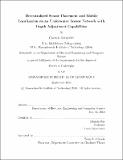Decentralized sensor placement and mobile localization on an underwater sensor network with depth adjustment capabilities
Author(s)
Detweiler, Carrick (Carrick James)
DownloadFull printable version (7.823Mb)
Other Contributors
Massachusetts Institute of Technology. Dept. of Electrical Engineering and Computer Science.
Advisor
Daniela Rus.
Terms of use
Metadata
Show full item recordAbstract
Over 70% of our planet is covered by water. It is widely believed that the underwater world holds ideas and resources that will fuel much of the next generation of science and business. Unfortunately, underwater operations are fraught with difficulty due to the absence of an easy way to collect and monitor data. In this thesis we propose a novel underwater sensor network designed to mitigate the problems of underwater sensing and communication. A key feature of this system is the ability of individual nodes to control their depth in water. This single degree of freedom allows the network to cooperatively optimize placement for communication and data collection while minimizing time and energy use. The sensor network also enables a GPS-like system for localizing underwater robots to aid in data retrieval and sensing. We develop a gradient-based decentralized controller that dynamically adjusts the depth of a network of underwater sensors to optimize sensing for modeling 3D properties of the water. We prove that the controller converges to a local minimum, and implement the controller on our underwater sensor network, where each node is capable of adjusting its depth. We verify the algorithm through simulations and in-water experiments. Most applications require that we associate a location with the sensed data. We have developed an underwater mobile robot localization algorithm that allows underwater robots to act as mobile sensors in the sensor network by using ranging information. The algorithm is a minimalist, geometric-based algorithm that only relies on knowing an upper bound on the robot speed and known static node locations. We prove that the algorithm finds the optimal location of the robot and analyze the algorithm in simulation and in water with our underwater sensor network.
Description
Thesis (Ph. D.)--Massachusetts Institute of Technology, Dept. of Electrical Engineering and Computer Science, 2010. This electronic version was submitted by the student author. The certified thesis is available in the Institute Archives and Special Collections. Cataloged from student-submitted PDF version of thesis. Includes bibliographical references (p. 203-214).
Date issued
2010Department
Massachusetts Institute of Technology. Department of Electrical Engineering and Computer SciencePublisher
Massachusetts Institute of Technology
Keywords
Electrical Engineering and Computer Science.